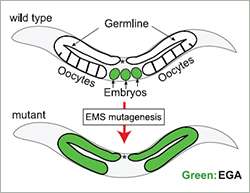Rafal Ciosk and his group at the FMI have identified an important regulator of the transition from germ cell to embryonic cell. LIN-41 prevents the premature onset of embryonic transcription in oocytes poised for embryonic development, thus ensuring a successful passage between generations. This finding also holds promise for efforts to reprogram differentiated human cells into induced pluripotent stem cells.
Fertilization triggers one of life's most sweeping transitions - the transition from one generation to the next and, most intriguingly for developmental biologists, from unipotent germ cells to pluripotent embryonic cells. During this transition, fully differentiated and totally specialized reproductive cells (oocytes and sperms) morph into embryonic cells with an unlimited potential to give rise, once again, to all the specialized cells in the body. It is as if a seasoned astronaut suddenly gained the potential to become a concert pianist, car mechanic, Formula One pilot, banker, physician or philosopher. A better understanding of this transition is essential for progress in stem cell therapy and regenerative medicine, where scientists are currently trying to coax fully differentiated cells, such as epithelial cells, into a more pluripotent state. Unfortunately, the underlying molecular processes are still largely unknown.
FMI scientists led by Rafal Ciosk have now identified a protein that prevents the premature onset of this transition, thus ensuring a successful passage between generations.
"Interestingly, the majority of 'molecular roadblocks' to reprogramming that have been identified so far are epigenetic regulators. Here, we show that - at least in germ cells - LIN-41 may fulfill an analogous role in the cytoplasm," comments Ciosk.
But the implications of Ciosk's findings may go beyond the worm: LIN-41 has recently been shown to promote reprogramming of differentiated human cells into induced pluripotent stem cells. "This is the beauty of the worm as a model organism. We can observe and interfere with fundamental processes in living organisms and thus identify candidates which are highly likely to be relevant in similar processes in humans."
More information: Tocchini C, Keusch JJ, Miller SB, Finger S, Gut H, Stadler MB, Ciosk R "The TRIM-NHL Protein LIN-41 Controls the Onset of Developmental Plasticity in Caenorhabditis elegans" PLoS Genet. 2014 Aug; 10(8):e1004533
Journal information: PLoS Genetics






















